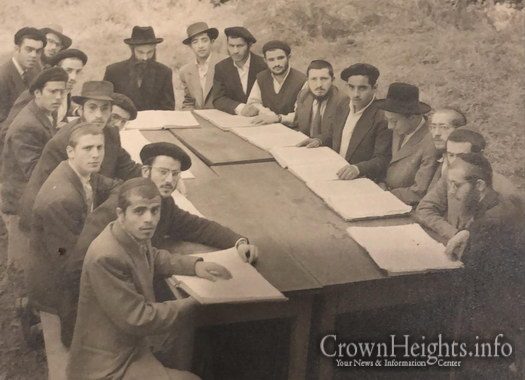
Weekly Story: Thirsting For Chassidus
Rabbi Sholom DovBer Avtzon
Last Shabbos was Yud Tes Kislev and there were numerous farbrengens throughout the community. Being that the Rebbe quite often describes the connection between Chanukah (which is this week), to Yud Tes Kislev, I decided to post some thoughts that I heard, at the various farbrengens, I participated in.
Your feedback is greatly appreciated.
Young Meir Sholom of Waraw Poland grew up in before WWII, and was a bochur with a great thirst to learning. As in many chassidishe communities, there was no official yeshiva. Rather the young men that had a desire to learn, sat in a local shul and learned on their own, and when they had a question, the Rov would answer it.
Although he was young, he sat in the shul and began learning. The Rov knew the family and informed them that their son is too young to be learning on his own. Meir Sholom’s mother asked the Rov to just test her son and see for himself if he is qualified to learn on his own, with boys a few years older than him. The Rov agreed and was surprised at his advanced level and allowed him to learn there.
After being there for some time, he noticed that almost every day a Jew came to shul to daven mincha and then instead of participating with others in learning, he would open up a sefer and learn by himself. Noticing the concentration as well as the elevated spirit that person experiencing, piqued his curiosity, as to what he was learning. So he sat behind him, and was able to hear the words, but couldn’t figure what sefer it was. The concepts were intriguing, but foreign to him which increased his interest.
After a few days, he decided that he must know what sefer it is and begin learning it himself. He waited until most people left after maariv, he then approached the individual and asked him what is the name of the sefer he learns every day.[1] The Jew, was Rabbi Schneur Zalman Shmotkin a Lubavitcher chossid, who lived in Warsaw, answered, “It is the Tanya.”
Meir Sholom told him that he would be interested in learning it, and believes that some of his chaverim would also be interested. Rabbi Shmotkin asked him, if the Pulsur Rov would allow them to learn, and he replied, we will learn secretly, after the regular hours of learning and keep it quiet.
Thus began a clandestine shiur in Tanya with ten students. But it was a small yeshiva and it didn’t take long, until the Rov found out that every once in a while the same ten students disappear at the same time. After some investigating and questioning them he found out that they were learning the Tanya. He informed them that just as a talmid chocham is not to learn Kabbala before the age of forty; our custom is that one doesn’t learn Chassidus until after they are married. Therefore in order for them to continue learning in his shul they must promise not to continue this study.
Of course it is holy, he said and it is important to learn the Tanya, but there is a time for that and that is later. In my shul, no bochur can learn Chassidus. Seeing that Meir Sholom wasn’t deterred and fearful that he will encourage other bochurim to also learn Chassidus, he warned him that he will become sick.
Meir Sholom continued to learn the Tanya and indeed he begin feeling sick. When his mother realized that it is not just a regular sickness she asked him what is ailing him. He told her what happened and he thinks it is a kepeida of the Rov.
She went to the Rov and asked him what happened and he reiterated his position that a bochur is not allowed to learn Chassidus. Her son is welcomed back if he promises to focus on nigla and no Chassidus.
When she repeated this to him and pleaded with him to watch his gezunt, he said, Mother, give me an hour to think. He then returned and said, “Better death than not learning Chassidus.” He then wrote a letter (a pa”n) to the Frierdiker Rebbe that nothing bad should happen to him.
Rabbi Shmotkin, met him and asked why is he no longer in the shul, and he told him what happened. Rabbi Shmotkin said, I am a businessman and I can open up a yeshiva for you ten bochurim.
Thus began Tomchei Tmimim in Warsaw in the beginning of Tammuz 5681 (1921), when the Rebbe was in Russia.
The Rebbe was informed of this and it gave him tremendous happiness. To help it develop into a yeshiva in the spirit of Tomchei Tmimim, he sent the Reb Alter Simchovitch to serve as the mashpia there.[2]
This young Meir Sholom became the noted chossid Reb Meir Sholom Blizinsky who taught and explained in a clear thoughtful way the teachings of Chassidus to thousands of Jews.
Heard from his grandson Rabbi Shmuel HaLevi Heber
In many of the farbrengens and in clips from various communities, it was noted how indeed the wellsprings of Chassidus are spreading outwards and is being embraced in communities that some years ago a shiur Tanya had to be given in secret. It is clear that it everyone sees the benefits of the light of Chassidus.
At one farbrengen it was noted that while the Jewish at large has developed a thirst for the insights of Chassidus, it is because they see that there was something they were missing, and Toras HaChassidus filled that void. However, we who grew up with it, don’t always appreciate what we have, as with everything in life; you only appreciate something when you can no longer have it. To some of us, it may bring back memories of our struggles when we first began learning Tanya or maamorim in Likkutei Torah and we didn’t appreciate at that time, its relevance.
However, one should realize that now that he is older and more mature and there are many seforim that explain the Tanya and maamorim in a simple and thoughtful manner, that they should give it another try. As the Alter Rebbe would say in his unique tune, Taamoo U’ri’oo Ki Tov Havaya – farzuch uhn doo vilst zhein as do Eibishter is guht – Taste and you will see the G-dliness is good.
It is mentioned in seforim that Chanukah is an acronym for the words Cheis Neiros V’halacha Ki’Beis Hillel – we are to light eight candles and follow the opinion of Beis Hillel. The question is, being that in general the halacha is like Beis Hillel, why is it important to say that here we follow Beis Hillel’s opinion (of adding an additional candle each day)?
It is discussed in the Zohar that when Moshiach comes the halachah would then be like Beis Shammai. One of the reasons why we light eight candles and not seven, (since the miracle was that it burned for an additional seven days), is; that eight is higher than nature which is symbolized by seven, as in the seven days of creation.
However, Chanukah is connected to higher than nature as indeed it was their mesiras nefesh that brought out this miracle. By laws of nature they were outnumbered and would have been defeated. By Halacha, if the entire community is impure than you can utilize the impure oil. But they went above nature and weren’t satisfied with finding a heter to use impure oil, they were only going to use pure oil.
The kinor (harp) in the third beis hamikdash is going to have eight branches, to symbolize that we are higher than nature.
So since Chanukah is connected to the third Beis Hamikdash, may it be built speedily in our days, (and therefore the sages inform us that the candles of Chanukah would be continued to be lit, even after the coming of Moshiach), so therefore there is reason to say that the halachah of the menorah now should follow the opinion of Beis Shammai, as then the halachah would be like him. Therefore the sages had to say, nevertheless, the halachah here is like Beis Hillel.
This weeks’ post is l’zechus the complete and immediate healing of my sister Chaya Rivkah bas Cheyena, together with all those who need a brocha in any aspect.
Rabbi Avtzon is a veteran mechanech and the author of numerous books on the Rebbeim and their chassidim/ He can be contacted at avtzonbooks@gmail.com
[1][1] Author’s note: It should be noted that this was before the Frierdiker Rebbe divided the Tanya to be learned throughout the year on a daily schedule. Nevertheless, as a chossid, he did not let a day go by without learning a few lines of Tanya.
[2] Igros kodesh of the Frierdiker Rebbe, vol. 1, p. 160.














